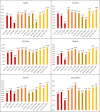National and regional trends in MRI utilization in the face of the ongoing COVID-19 pandemic
- PMID: 34266476
- PMCID: PMC8280577
- DOI: 10.1186/s13584-021-00472-y
National and regional trends in MRI utilization in the face of the ongoing COVID-19 pandemic
Abstract
Background and purpose: Marked reductions in imaging exams have been documented during the COVID-19 pandemic. The study aimed to examine the effect of the two waves of COVID-19 on magnetic resonance imaging (MRI) utilization at the national and regional level.
Materials and methods: A retrospective-archive study was conducted in Israel, comparing March-December 2020 with March-December 2018 and 2019. Data on MRI utilization were obtained from the national MRI registry, while data on confirmed COVID-19 cases, by place of residence, were obtained from the Israeli Ministry of Health open COVID-19 database.
Results: The number and rate of MRI examinations decreased during the first COVID-19 wave, with the steepest drop in April 2020: 47.5% relative decrease compared to April 2019, and 42.2% compared to 2018. This was followed by a compensatory increase between the waves and a return to almost pre-pandemic levels of use, with just a modest decrease, during the second, more intense COVID wave, compared with the previous year. Existing differences between regions increased during the pandemic. The rate ratio of MRI exams between Tel-Aviv and the Northern periphery increased from 2.89 in April 2019 to 3.94 in April 2020. Jerusalem metropolitan region, with the largest burden of COVID disease, demonstrated only a modest decrease (1%) in MRI utilization during the first 10 months of the pandemic.
Conclusions: At the national level, time trends in reduced MRI utilization followed the first wave of COVID-19, and were accompanied by increased regional disparities. These changes were not explained by differences in the burden of COVID-19 disease but might be explained by unequal distribution of MRI scanners among regions. Reduced utilization was not evident during the second wave, nor at the beginning of the third wave, despite higher COVID-19 case load, demonstrating adaptation to the new normal. Patterns of MRI utilization might help policy-makers and healthcare managers predict the behavior of imaging as well as other sectors, such as elective surgical procedures, during an ongoing pandemic. This forecast might help to manage the lasting effects of the pandemic, including extended waiting times, in the months and years following its remission. In preparation for future national emergencies, timely and detailed data on MRI utilization can serve as a "sensor" for a wide array of diagnostic and interventional medical activities, providing policy-makers with an updated snapshot to guide their response at the regional and national levels.
Keywords: COVID-19; Pandemic; Wave, Disparity, MRI exam.
© 2021. The Author(s).
Conflict of interest statement
All authors declare no conflict of interest.
Figures




Similar articles
-
Socioeconomic and ethnic disparities along five waves of the COVID-19 pandemic: Lessons we have not yet learnt.J Nurs Scholarsh. 2023 Jan;55(1):45-55. doi: 10.1111/jnu.12816. Epub 2022 Oct 11. J Nurs Scholarsh. 2023. PMID: 36218245 Free PMC article.
-
The impact of COVID-19 pandemic on emergency department visits and associated mortality during 14 months of the pandemic in Israel.Intern Emerg Med. 2022 Sep;17(6):1699-1710. doi: 10.1007/s11739-022-02991-1. Epub 2022 May 16. Intern Emerg Med. 2022. PMID: 35576046 Free PMC article.
-
Impact of COVID-19 pandemic waves on changes in surgical urgency volumes and severity in the regional hospital network of Trento (Northern Italy): a descriptive epidemiological analysis.Epidemiol Prev. 2021 Nov-Dec;45(6):470-476. doi: 10.19191/EP21.6.131. Epidemiol Prev. 2021. PMID: 35001595 English.
-
Fourth Wave of Opioid (Illicit Drug) Overdose Deaths and Diminishing Access to Prescription Opioids and Interventional Techniques: Cause and Effect.Pain Physician. 2022 Mar;25(2):97-124. Pain Physician. 2022. PMID: 35322965 Review.
-
Evaluation of the representativeness of data in the COVID-19 Registry Japan during the first six waves of the epidemic.Glob Health Med. 2022 Aug 31;4(4):204-209. doi: 10.35772/ghm.2022.01033. Glob Health Med. 2022. PMID: 36119783 Free PMC article. Review.
Cited by
-
Quantifying effects of blood pressure control on neuroimaging utilization in a large multi-institutional healthcare population.PLoS One. 2024 Apr 30;19(4):e0298685. doi: 10.1371/journal.pone.0298685. eCollection 2024. PLoS One. 2024. PMID: 38687816 Free PMC article.
-
A tale of two times: an exploration of healthcare utilization patterns before and during COVID-19 in Iran.BMC Public Health. 2024 Oct 25;24(1):2961. doi: 10.1186/s12889-024-20452-6. BMC Public Health. 2024. PMID: 39455941 Free PMC article.
-
Scheduling an appointment for MRI: patient perception of wait time and difficulty.Isr J Health Policy Res. 2025 Mar 26;14(1):14. doi: 10.1186/s13584-025-00677-5. Isr J Health Policy Res. 2025. PMID: 40140943 Free PMC article.
-
Impact of the COVID-19 pandemic on imaging case volumes in King Abdullah University Hospitals (KAUH).Front Med (Lausanne). 2023 Feb 9;10:1103083. doi: 10.3389/fmed.2023.1103083. eCollection 2023. Front Med (Lausanne). 2023. PMID: 36844230 Free PMC article.
-
Self-reported delays in care-seeking in West Africa during the first wave of the COVID-19 pandemic.BMC Health Serv Res. 2023 Jul 22;23(1):785. doi: 10.1186/s12913-023-09812-x. BMC Health Serv Res. 2023. PMID: 37481561 Free PMC article.
References
-
- Garcia S, Albaghdadi MS, Meraj PM, Schmidt C, Garberich R, Jaffer FA, Dixon S, Rade JJ, Tannenbaum M, Chambers J, Huang PP, Henry TD. Journal pre-proof reduction in ST-segment elevation cardiac catheterization laboratory activations in the United States during COVID-19 pandemic. J Am Coll Cardiol. 2020;75(22):2871–2872. doi: 10.1016/j.jacc.2020.04.011. - DOI - PMC - PubMed
MeSH terms
LinkOut - more resources
Full Text Sources
Medical
Miscellaneous

